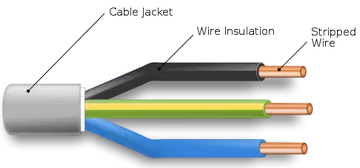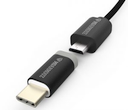cable
A rope is a group of yarns, plies, fibers or strands that are twisted or braided together into a larger and stronger form. Ropes have tensile strength and so can be used for dragging and lifting. Rope is thicker and stronger than similarly constructed cord, string, and twine. Wire rope is several strands of metal wire twisted into a helix forming a composite rope, in a pattern known as laid rope. Larger diameter wire rope consists of multiple strands of such laid rope in a pattern known as cable laid.
A Bowden cable is a type of flexible cable used to transmit mechanical force or energy by the movement of an inner cable relative to a hollow outer cable housing. The housing is generally of composite construction, consisting of an inner lining, a longitudinally incompressible layer such as a helical winding or a sheaf of steel wire, and a protective outer covering. Bowden cable with a barrel adjuster controlling a bicycle rear derailleur:

An electrical cable is an assembly of one or more wires running side by side or bundled, which is used to carry electric current.

A power cable is an electrical cable, an assembly of one or more electrical conductors, usually held together with an overall sheath. The assembly is used for transmission of electrical power. Power cables may be installed as permanent wiring within buildings, buried in the ground, run overhead, or exposed. Power cables that are bundled inside thermoplastic sheathing and that are intended to be run inside a building are known as NM-B (nonmetallic sheathed building cable).
Here is how you can charge and sync your USB-C mobile devices using a Micro-USB cable. Insert the adapter's USB-C connector into your mobile device. Then, plug your Micro-USB cable into the adapter's Micro-USB port and connect the cable to the USB-A port on your computer or USB-A wall charger:

A submarine communications cable is a cable laid on the sea bed between land-based stations to carry telecommunication signals across stretches of ocean and sea. The first submarine communications cables laid beginning in the 1850s carried telegraphy traffic, establishing the first instant telecommunications links between continents, such as the first transatlantic telegraph cable which became operational on 16 August 1858. Subsequent generations of cables carried telephone traffic, then data communications traffic. Modern cables use optical fibre technology to carry digital data, which includes telephone, Internet and private data traffic.
Cable television is a system of delivering television programming to consumers via radio frequency (RF) signals transmitted through coaxial cables, or in more recent systems, light pulses through fibre-optic cables. This contrasts with broadcast television (also known as terrestrial television), in which the television signal is transmitted over-the-air by radio waves and received by a television antenna attached to the television; or satellite television, in which the television signal is transmitted over-the-air by radio waves from a communications satellite orbiting the Earth, and received by a satellite dish antenna on the roof. FM radio programming, high-speed Internet, telephone services, and similar non-television services may also be provided through these cables. Analog television was standard in the 20th century, but since the 2000s, cable systems have been upgraded to digital cable operation.
A Coaxial Cable used to carry cable television onto subscribers' premises:

A "cable channel" (sometimes known as a "cable network") is a television network available via cable television. The abbreviation CATV is often used for cable television. It originally stood for Community Access Television or Community Antenna Television, from cable television's origins in 1948.
At the regional headend , the TV channels are sent multiplexed on a light beam which travels through optical fiber trunklines, which fan out from distribution hubs to optical nodes in local communities. Here the light signal from the fiber is translated to a radio frequency electrical signal, which is distributed through coaxial cable to individual subscriber homes.
Coaxial cables are capable of bi-directional carriage of signals as well as the transmission of large amounts of data. Cable television signals use only a portion of the bandwidth available over coaxial lines. This leaves plenty of space available for other digital services such as cable internet, cable telephony and wireless services, using both unlicensed and licensed spectrum. Broadband internet access is achieved over coaxial cable by using cable modems to convert the network data into a type of digital signal that can be transferred over coaxial cable.
六级/考研单词: fibre, strand, twist, likewise, construct, cord, spiral, composite, diameter, multiple, rigid, transmit, outer, hollow, rear, assemble, bundle, install, perpetual, overhead, exposition, submarine, telecommunications, continent, data, digit, consume, pulse, podcast, antenna, satellite, orbit, upgrade, subscribe, abbreviation, seldom, beam, translate, portion, spectrum, convert




 浙公网安备 33010602011771号
浙公网安备 33010602011771号